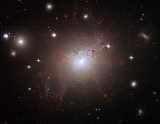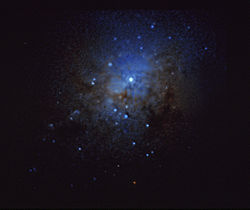
NGC 1275
Encyclopedia
NGC 1275 is a type 1.5 Seyfert galaxy
located around 237 million light-year
s away in the direction of the constellation
Perseus
. NGC 1275 corresponds to the radio galaxy
Perseus A and is situated near the centre of the large Perseus Cluster
of galaxies. It is morphologically a type-cD galaxy
.
 NGC 1275 consists of two galaxies, the central CD Galaxy in the Perseus Cluster
NGC 1275 consists of two galaxies, the central CD Galaxy in the Perseus Cluster
, and the so-called "high velocity system" (HVS) which lies in front of it. The HVS is moving at 3000 km/s towards the dominant system, and is believed to be merging with the Perseus Cluster
. The HVS is not affecting the CD Galaxy as it lies at least 200 thousand light years from it. The central cluster galaxy contains a massive network of spectral line
emitting filaments, which appear to be being dragged out by rising bubbles of relativistic
plasma
generated by the central active galactic nucleus
. Long gaseous filaments made up of threads of gas stretch out beyond the galaxy, into the multimillion-degree, X-ray–emitting gas that fills the cluster. The amount of gas contained in a typical thread is approximately one million times the mass of our own Sun. They are only 200 light-years wide, are often very straight, and extend for up to 20,000 light-years.
The existence of the filaments poses a problem. As they are much cooler than the surrounding intergalactic cloud, how have they persisted for perhaps 100 million years? Why haven’t they warmed, dissipated or collapsed to form stars? One possibility is that weak magnetic fields (about one-ten-thousandth the strength of Earth’s field) exert enough force on the ion
s within the threads to keep them together.
Seyfert galaxy
Seyfert galaxies are a class of galaxies with nuclei that produce spectral line emission from highly ionized gas, named after Carl Keenan Seyfert, the astronomer who first identified the class in 1943...
located around 237 million light-year
Light-year
A light-year, also light year or lightyear is a unit of length, equal to just under 10 trillion kilometres...
s away in the direction of the constellation
Constellation
In modern astronomy, a constellation is an internationally defined area of the celestial sphere. These areas are grouped around asterisms, patterns formed by prominent stars within apparent proximity to one another on Earth's night sky....
Perseus
Perseus (constellation)
Perseus is a constellation in the northern sky, named after the Greek hero Perseus. It was one of the 48 constellations listed by the 2nd century astronomer Ptolemy, and remains one of the 88 modern constellations defined by the International Astronomical Union...
. NGC 1275 corresponds to the radio galaxy
Radio galaxy
Radio galaxies and their relatives, radio-loud quasars and blazars, are types of active galaxy that are very luminous at radio wavelengths, with luminosities up to 1039 W between 10 MHz and 100 GHz. The radio emission is due to the synchrotron process...
Perseus A and is situated near the centre of the large Perseus Cluster
Perseus Cluster
The Perseus Cluster is a cluster of galaxies in the constellation Perseus. It has a recession speed of 5,366 km/s and a diameter of 863′...
of galaxies. It is morphologically a type-cD galaxy
Type-cD galaxy
The type-cD galaxy is a galaxy morphology classification, a subtype of type-D giant elliptical galaxy, and has a large halo of stars. They can be found near the centres of some rich galaxy clusters...
.
Dynamics

Perseus Cluster
The Perseus Cluster is a cluster of galaxies in the constellation Perseus. It has a recession speed of 5,366 km/s and a diameter of 863′...
, and the so-called "high velocity system" (HVS) which lies in front of it. The HVS is moving at 3000 km/s towards the dominant system, and is believed to be merging with the Perseus Cluster
Perseus Cluster
The Perseus Cluster is a cluster of galaxies in the constellation Perseus. It has a recession speed of 5,366 km/s and a diameter of 863′...
. The HVS is not affecting the CD Galaxy as it lies at least 200 thousand light years from it. The central cluster galaxy contains a massive network of spectral line
Spectral line
A spectral line is a dark or bright line in an otherwise uniform and continuous spectrum, resulting from a deficiency or excess of photons in a narrow frequency range, compared with the nearby frequencies.- Types of line spectra :...
emitting filaments, which appear to be being dragged out by rising bubbles of relativistic
Theory of relativity
The theory of relativity, or simply relativity, encompasses two theories of Albert Einstein: special relativity and general relativity. However, the word relativity is sometimes used in reference to Galilean invariance....
plasma
Plasma (physics)
In physics and chemistry, plasma is a state of matter similar to gas in which a certain portion of the particles are ionized. Heating a gas may ionize its molecules or atoms , thus turning it into a plasma, which contains charged particles: positive ions and negative electrons or ions...
generated by the central active galactic nucleus
Active galactic nucleus
An active galactic nucleus is a compact region at the centre of a galaxy that has a much higher than normal luminosity over at least some portion, and possibly all, of the electromagnetic spectrum. Such excess emission has been observed in the radio, infrared, optical, ultra-violet, X-ray and...
. Long gaseous filaments made up of threads of gas stretch out beyond the galaxy, into the multimillion-degree, X-ray–emitting gas that fills the cluster. The amount of gas contained in a typical thread is approximately one million times the mass of our own Sun. They are only 200 light-years wide, are often very straight, and extend for up to 20,000 light-years.
The existence of the filaments poses a problem. As they are much cooler than the surrounding intergalactic cloud, how have they persisted for perhaps 100 million years? Why haven’t they warmed, dissipated or collapsed to form stars? One possibility is that weak magnetic fields (about one-ten-thousandth the strength of Earth’s field) exert enough force on the ion
Ion
An ion is an atom or molecule in which the total number of electrons is not equal to the total number of protons, giving it a net positive or negative electrical charge. The name was given by physicist Michael Faraday for the substances that allow a current to pass between electrodes in a...
s within the threads to keep them together.
External links
- APOD (2003-05-05) – NASA image & description
- APOD (2005-07-25) – NASA image showing unusual gas filaments
- Fabian, A.C., et al. "A deep Chandra observation of the Perseus cluster: shocks and ripples". Monthly Notices of the Royal Astronomical Society. Vol. 344 (2003): L43 (arXiv:astro-ph/0306036v2).
- Fabian, A.C. Nature 454, 968-970.
- Gabany, R. Jay. cosmotography.com – An image made with a 20" telescope, which displays the unusual gas filaments

